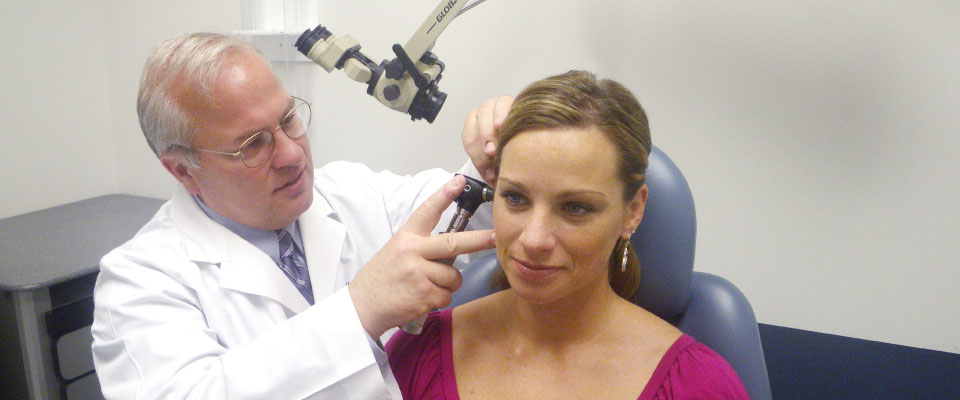Zenker’s Diverticulum
A Zenker’s diverticulum (ZD) is a rare condition where an “outpouching” occurs where your throat meets your esophagus, the swallowing pipe that leads into your stomach. When this happens, a pouch forms and mucous, food, and/or liquid can become stuck instead of going down your esophagus and into your stomach like normal.
What Are the Symptoms of ZD?
If you have a ZD, you may experience:
- Difficulty swallowing
- Regurgitating or vomiting undigested food hours after eating
- Inhaling food or saliva down your windpipe (called aspiration)
- Belching
- Noisy swallowing
- Bad breath
- Choking
- Coughing
- Hoarseness
- Feeling like something is stuck in the back of your throat
- Weight loss
- Recurrent lung infections in severe cases
What Causes ZD?
ZD is most commonly caused by increased tension in the muscle at the top of your esophagus (called the cricopharyngeus muscle), which obstructs the proper passage of food and liquids into your stomach.
What Are the Treatment Options?
If you have any of the symptoms mentioned here, you should be examined by an ENT (ear, nose, and throat) specialist, or otolaryngologist. Your ENT specialist may diagnose your condition using a “barium swallow” study. This is a special type of X-ray test that helps your doctor take a closer look at the back of your mouth, throat, and esophagus to see how you swallow food and liquid.
There are no current medications to treat ZD, so the usual treatment is surgery unless your ZD is small and doesn’t cause too much difficulty or discomfort. If your doctor recommends surgery, however, there are several options including making an incision on the neck, as opposed to a less-invasive approach through the mouth.
For open surgery, a small incision is made in the neck and the pouch is either removed or tacked upside down so that it doesn’t collect food. During this procedure the muscle below the ZD, your cricopharyngeus muscle, is cut to prevent recurrence of the ZD. Most patients stay in the hospital for a few days after surgery to recover from this procedure.
During an endoscopy or approach through the mouth to make repairs, there are no incisions on the outside of the neck. With this approach, a stapling device is used to divide the wall between the esophagus and the ZD to make a common cavity for food and liquid to flow directly into the esophagus without becoming stuck. Your doctor can discuss the pros and cons of each procedure and help you choose the best option for you.
Following surgery, you may notice:
- A sore throat
- Pain in your ears
- Pain at your incision site
- Pain in your jaw joints
You should call your ENT specialist if you experience any of these post-surgical symptoms:
- If you have a hard time breathing (go to ER or call 911)
- If you have signs of a wound infection (fever, redness, swelling, tenderness, pus-like drainage)
- If you have chest, upper back, or neck pain
- If you cough up or vomit more than a few tablespoons of blood
- If you have a fever over 101 degrees Fahrenheit
What Questions Should I Ask My Doctor?
- What can I eat following surgery?
- Will I have pain?
- Will a ZD reoccur after it has been removed?
References
Overbeek JJM. Pathogenesis and methods of treatment of Zenker’s diverticulum. Ann Otol Rhinol Laryngol 2003;112:583–593.
Phillepsen LP, Weisberger EC, Whiteman TS, Schmidt JL. Endoscopic stapled diverticulotomy: treatment of choice for Zenker’s diverticulum. Laryngoscope 2000;110:1283–1286.
Leibowitz JM, Fundakowski CE, Abouyared M, et al. Surgical techniques for Zenker’s diverticulum: a comparative analysis. Otolaryngol Head Neck Surg 2014;151:52–58.
Voice Box (Laryngeal) Cancer
Cancer of the voice box, or laryngeal cancer, is not as well known by the general public as some other types of cancer, yet it is not a rare disease. The American Cancer Society estimates that there will be about 13,150 new cases of laryngeal cancer (10,490 new cases in men and 2,660 new cases in women), and about 3,710 deaths from laryngeal cancer (2,970 men and 740 women). [1] Even for survivors, the consequences of laryngeal cancer can be devastating with respect to voice, breathing, or swallowing. It is a preventable disease, however, since the primary risk factors for laryngeal cancer are associated with changeable behaviors in lifestyle.
What Are the Symptoms of Laryngeal Cancer?
Signs and symptoms of laryngeal cancer include:
- Worsening or persistent hoarseness
- Difficulty swallowing
- Persistent sore throat or pain with swallowing
- Difficulty breathing
- Pain in the ear
- Lump in the neck
- Coughing up blood
Anyone with these signs or symptoms should be evaluated by an ENT (ear, nose, and throat) specialist, or otolaryngologist. This is particularly important for people with risk factors for laryngeal cancer.
What Are the Causes and Risk Factors Associated with Laryngeal Cancer?
Many factors can lead to the development of laryngeal cancer, including certain viruses such as human papilloma virus (HPV), but approximately 90 percent of head and neck cancers occur after exposure to known cancer-causing substances, called carcinogens. Chief among these factors is tobacco. Over 90 percent of laryngeal cancers are a type of cancer called squamous cell carcinoma (SCCA), and over 95 percent of patients with laryngeal SCCA are smokers. Smoking contributes to cancer development by causing mutations or changes in genes, preventing carcinogens from being cleared from the respiratory tract, and decreasing the body’s immune response.
Tobacco use is measured in pack-years. For example, two pack-years is defined as either one pack per day for two years, or two packs per day for one year (longer terms of pack-years are determined using a similar ratio). Depending upon the number of pack-years smoked, studies have reported that smokers are about five to 35 times more likely to develop laryngeal cancer than non-smokers. The longer you are exposed to tobacco is probably more important to developing cancer than the intensity of the exposure.
Alcohol is another important risk factor for laryngeal cancer because it promotes the cancer-causing process, especially in the presence of tobacco. People who smoke and drink alcohol have a combined risk that is greater than the sum of the individual risks. Other risk factors for laryngeal cancer include HPV and acid reflux.
What Are the Treatment Options?
The best “treatment” is prevention: laryngeal cancer is a preventable disease in most cases, because the main risk factors are associated with lifestyle behaviors that can be modified or changed. The American Cancer Society recommends that those who drink alcoholic beverages should limit the amount of alcohol they consume—one drink per day is considered limited exposure to alcohol. It also recommends avoiding tobacco in any form. Vitamin A and beta-carotene may play a protective role in helping to decrease the risk of developing laryngeal cancer.
That said, the primary treatment options for laryngeal cancer include surgery, radiation therapy, chemotherapy, or a combination of these treatments, the first two being the most commonly recommended treatments. However, these treatments take a toll on the body.
Potential Complications of Non-treatment
You and your doctor can discuss the best treatment option(s), but potential complications of not treating your condition include:
- Persistent sore throat
- Complete loss of voice
- Disfigurement in the neck area
- Bloody cough or bleeding from the mouth
- Complete inability to swallow or aspiration of food and liquid into lungs leading to pneumonia
- Difficulty breathing or even complete airway blockage, possibly requiring a tracheostomy (a special tube through the neck into the trachea or windpipe to bypass the blocked airway)
What Questions Should I Ask My Doctor?
- What is the stage and grade of the cancer? What does this mean?
- Can you explain my pathology report (laboratory test results) to me?
- Does my cancer need to be genetically tested? Are there any other special tests that have to be done on the pathology slides?
- Can my cancer be cured? If not, why?
- What are my treatment options?
- What clinical trials are available for me? Where are they located, and how do I find out more about them?
- What are the side effects of each type of treatment? How are the side effects prevented or managed?
- What is the goal of each treatment? Is it to eliminate the cancer, help me feel better, or both?
- What are the possible short- and long-term side effects of each treatment option?
- How will this treatment affect my daily life? Will I be able to work, exercise, and perform my usual activities?
- Will treatment affect my ability to speak, eat, and swallow?
- What is the chance that the cancer will come back? Should I watch for specific signs or symptoms?
- What kind of dental care do I need? How often should I see the dentist?
- Do I need to change my diet? Are there certain foods that I should avoid? Can I drink alcohol?
- Will I need cancer rehabilitation services after treatment? What can I expect?
References
[1] https://www.cancer.org/cancer/laryngeal-and-hypopharyngeal-cancer/about/key-statistics.html
Vocal Cord (Fold) Paralysis
People have one set of two vocal cords, also known as vocal folds, that work together in your voice box to produce sound. They open when you breathe in to let the air flow through your lungs, and they close and vibrate when you speak (this is called phonation). To produce adequate voice, both vocal cords should move toward each other and close completely to vibrate together (this is called glottic closure).
Your vocal cords move through the contraction of various muscles controlled by your brain and a specific set of nerves. Vocal cord paralysis and paresis can result from abnormal function of the nerves that control your voice box muscles (laryngeal muscles). Paralysis is a complete absence of vocal cord movement, caused by a complete loss of nerve input; paresis is a weakened vocal cord movement, caused by a partial loss of nerve input. There are two nerves that can be involved:
- The recurrent laryngeal nerve (RLN) carries signals to different voice box muscles responsible for opening, closing, and adjusting tension in the vocal cords. Healthy function of this nerve is needed for breathing, speaking, coughing, and swallowing. The RLN goes into the chest cavity and curves back into the neck until it reaches your voice box. Because the nerve is relatively long and takes a “detour” to the voice box, it can be damaged or compressed by tumors in the neck or chest, or injured after surgery to the neck or chest.
- The superior laryngeal nerve (SLN) carries signals to a small muscle (called the cricothyroid) that controls your pitch. This muscle adjusts the tension of the vocal cord for high notes during singing (like a guitar string). An injury or damage to the SLN can cause inability to increase pitch when singing or reach higher notes.
Depending on your needs, vocal cord paralysis can cause great difficulty, or only mild problems. For instance, if you’re a professional singer, even mild paresis might end your career; if you’re a computer programmer, however, you might see little ill effect.
What Are the Symptoms of Vocal Cord Paralysis?
Symptoms of paralysis and paresis of the vocal cords can include:
- Voice changes—Hoarseness, breathy voice, weak voice, gurgling quality to the voice, shortness of breath after speaking
- Airway problems—Shortness of breath with efforts, noisy breathing, unsuccessful cough
- Swallowing problems—Choking or coughing when swallowing food, drink, or saliva, and food sticking in throat
These symptoms can be mild to severe depending on the degree of paralysis, and the ability of your voice box to adapt. Depending on the cause, your symptoms may resolve with time or persist.
What Causes Vocal Cord Paralysis?
Vocal cord paralysis can happen at any age and come from different causes, including:
- Idiopathic—An idiopathic vocal cord paralysis means that no specific cause could be found despite diagnostic tests. This happens in up to 50 percent of cases. One theory is that the common cold virus may cause nerve inflammation.
- Unplanned injury during surgery—Surgery in the neck (thyroid gland, carotid artery, cervical spine) or in the chest (lungs, esophagus, heart, or large blood vessels) may cause RLN or SLN paresis or paralysis.
- Breathing tube/intubation—Though rare, injury to the RLN may occur when breathing tubes are inserted to assist breathing for an extended period of time (in the intensive care unit, for example).
- Tumors of the skull base, neck, and chest—Tumors (both cancerous and non-cancerous) can grow around nerves and squeeze them, resulting in varying degrees of paresis or paralysis.
- Viral infections—Inflammation from infections may injure a brain nerve (called the vagus) or its nerve branches to the voice box (RLN and SLN). Illnesses affecting nerves in the whole body may also affect the voice box nerves.
- Auto-immune diseases—Various auto-immune diseases can cause transient or permanent vocal cord paralysis.
- Neurological causes—Strokes and other neurological diseases can cause vocal cord paralysis.
How is Vocal Cord Paralysis Diagnosed?
If you suffer from symptoms of vocal cord paralysis, you should see an ENT (ear, nose, and throat) specialist, or otolaryngologist, who may diagnose your condition from one or more of these methods:
- Flexible laryngoscopy—After asking questions about your symptoms, an examination of your voice box will be carried out, using a small, flexible camera that goes through your nose and down your throat to examine the voice box. If this exam reveals vocal cord paralysis or paresis, further tests can be ordered to determine the cause of the paralysis.
- CT scan—A CT scan of the head, neck, and/or chest can be ordered to make sure there is no mass or lesion compressing the nerve along its course in the body.
- Blood work—Blood tests can be ordered to test for auto-immune diseases.
- Laryngeal electromyography (LEMG)—A LEMG test measures electrical currents in the voice box muscles that are the result of nerve signals. Your doctor may have you perform certain tasks to test these muscles, then look at the pattern of electrical currents to see whether the nerve signals show signs of recovery or repair, and to determine the degree of the nerve problem.
What Are the Treatment Options?
Depending on the severity of your vocal cord paralysis and how much it affects your everyday life, your ENT specialist can offer different treatments options, including:
Voice therapy—Like physical therapy for an injured knee, voice therapy can help improve vocal function before having to consider surgery.
Surgery—The decision to have surgery depends on the degree of the symptoms, voice needs, position of the problem vocal cord, the outlook for recovery, and the cause of the problem, if known. There are two main types of surgical procedures to treat vocal cord paralysis:
- Vocal cord injection—A filling material is injected into the vocal cord to close the gap between your vocal cords. This can be done while you are awake (sometimes in your doctor’s office or in the operating room) or while you are asleep in an operating room. The duration of results will vary depending on the material injected.
- Laryngeal framework surgery (also called medialization laryngoplasty)—Your surgeon will make a small incision in your neck and insert an implant into your voice box to move your vocal cord toward the middle, helping both cords close and vibrate better. Commonly used implants include silastic blocks (silastic is a form of silicone gel) or Gore-Tex sheets. This procedure is often done under local anesthesia in the operating room, and the results are typically permanent.
If you suffer from vocal cord paralysis, your doctor will be able to guide you and find the best treatment options for your symptoms and needs.
What Questions Should I Ask My Doctor?
- What is the cause of my vocal cord paralysis?
- Is my vocal cord completely paralyzed or only partially paralyzed?
- Does vocal cord paralysis affect my ability to swallow properly?
- What are the chances of recovery if I don’t pursue any treatment?
- What are the chances of complications (e.g., aspiration pneumonia or swallowing problems) if I don’t pursue any treatment?
Tonsils and Adenoids
Tonsils are the two round lumps in the back of your throat. Adenoids are high in the throat behind the nose and the roof of the mouth (referred to as your soft palate). They are not visible through the mouth or nose without special instruments.
Tonsils and adenoids are part of the immune system and help protect the body from disease. They “sample” bacteria and viruses that enter through the mouth or nose. Unfortunately, sometimes they can get infected or cause problems by being too large.
What Are the Symptoms of Tonsil and Adenoid Difficulty?
Tonsillitis is an infection of the tonsils. Symptoms may include:
- Swelling of the tonsils
- Redder than normal tonsils
- A white or yellow coating on the tonsils
- A slight change in the voice due to swelling
- Sore throat sometimes accompanied by ear pain
- Uncomfortable or painful swallowing
- Swollen lymph nodes (glands) in the neck
- Fever
- Bad breath
If your or your child’s tonsils or adenoids are enlarged, it may be hard to breathe through the nose, or cause difficulty while sleeping. Other signs of adenoid and/or tonsil enlargement include:
- Breathing through the mouth instead of the nose most of the time
- Nose sounds “blocked” when the person speaks
- Chronic runny nose
- Noisy breathing during the day
- Recurrent ear infections
- Snoring at night
- Restlessness during sleep, or pauses in breathing for a few seconds at night (this may indicate sleep apnea, or other sleeping disorder)
You should see your ENT (ear, nose, and throat) specialist, or otolaryngologist, when you or your child experience the common symptoms of infected or enlarged tonsils or adenoids.
What Causes Difficulties in Tonsils and Adenoids?
The two most common problems of the tonsils and adenoids are caused by infection. Tonsil swelling can block the airway, or a person can experience repeated bacterial infections. These infections can contribute to breathing problems, nasal obstruction and swallowing difficulties, and sleep problems.
Abscesses around the tonsils, chronic tonsillitis, and infections of small pockets within the tonsils that produce foul-smelling white deposits can also affect the tonsils and adenoids, making them sore and swollen. Cancers of the tonsil, while uncommon, require early diagnosis and aggressive treatment.
What Are the Treatment Options?
Your physician will ask about problems of the ear, nose, and throat, and examine the head and neck. They may use a small mirror or a flexible lighted instrument to see these areas. Other methods used to check tonsils and adenoids are:
- Throat cultures or strep tests to identify infections in the throat
- A small, flexible scope to visualize the size of the adenoids; an X-ray may also be ordered
- Blood tests to diagnose infections such as mononucleosis
- Sleep study, or polysomnogram, to help decide whether sleep apnea is present and if sleep disturbance may be due to enlarged tonsils and adenoids
Bacterial infections of the tonsils, especially those caused by streptococcus, are first treated with antibiotics. Tonsillectomy, removal of the tonsils and/or adenoids (adenoidectomy), can be an option when infections return frequently even after antibiotic therapy or there is difficulty breathing with the enlarged tonsils and/or adenoids.
Frequent infections of the adenoids can affect other areas such as the ear’s passage between the back of the nose and the inside of the ear, known as the eustachian tube. This can lead to frequent ear infections and collection of fluid in the middle ear that may cause temporary hearing loss. Removal of the adenoids may help some children with chronic earaches accompanied by fluid in the middle ear (called otitis media with effusion).
In adults, the possibility of cancer or a tumor may be another reason for removing the tonsils and adenoids. In some patients, especially those with infectious mononucleosis, severe enlargement may obstruct the airway. For those patients, treatment with steroids (e.g., prednisone) is sometimes helpful.
What Questions Should I Ask My Doctor?
- Are my tonsils or adenoids enlarged?
- Could my snoring, sleep difficulty, or daytime sleepiness be related to sleep apnea?














